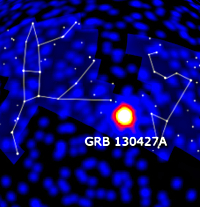 HEAPOW: Burst of Knowledge (2013 Nov 25)
HEAPOW: Burst of Knowledge (2013 Nov 25)
A definition of luck is preparation meeting opportunity. Last April 27, astronomers were very lucky when one of the brightest gamma-ray bursts occurred at a time when a full complement of gamma-ray and X-ray observatories, including the Fermi Gamma-ray Space Telescope, Swift, and NASA's newest high-energy observatory, NuSTAR, were able to observe it. This capability allowed astronomers to measure the burst's brightness over a range of one million in energy, and enabled astronomers to pinpoint its location using the Large Area Telescope (LAT) on Fermi (shown above), along with the imaging capabilities of Swift (at soft X-ray energies) and, for the first time, at hard X-ray energies with NuSTAR. Gamma ray bursts like the one that occurred on April 27 mark the explosive transformation of a mssive star into a black hole, and these new data provide an unprecedented look at this process. Astronomers are using these data, along with optical ground-based data from the RAPTOR telescopes, to create a detailed model of the structure of the shock waves which generate the observed emission.
NASA Sees 'Watershed' Cosmic Blast in Unique Detail
NuSTAR Observations of GRB 130427A Establish a Single Component Synchrotron Afterglow Origin for the Late Optical to Multi-GeV Emission
- Astrophysical Journal Letters 779(1) L1 (21 Nov 2013) DOI: 10.1088/2041-8205/779/1/L1
arXiv.org > astro-ph > arXiv:1311.5245 > 20 Nov 2013
- Science Express (Online 21 Nov 2013) DOI: 10.1126/science.1242279
arXiv.org > astro-ph > arXiv:1311.5254 > 20 Nov 2013
- Science Express (Online 21 Nov 2013) DOI: 10.1126/science.1242316
arXiv.org > astro-ph > arXiv:1311.5489 > 21 Nov 2013
- Science Express (Online 21 Nov 2013) DOI: 10.1126/science.1242302
arXiv.org > astro-ph > arXiv:1311.5581 > 21 Nov 2013
- Science Express (Online 21 Nov 2013) DOI: 10.1126/science.1242353
arXiv.org > astro-ph > arXiv:1311.5623 > 22 Nov 2013 (v1)
| << Previous HEAPOW | High Energy Astrophysics Picture of the Week | Next HEAPOW >> |